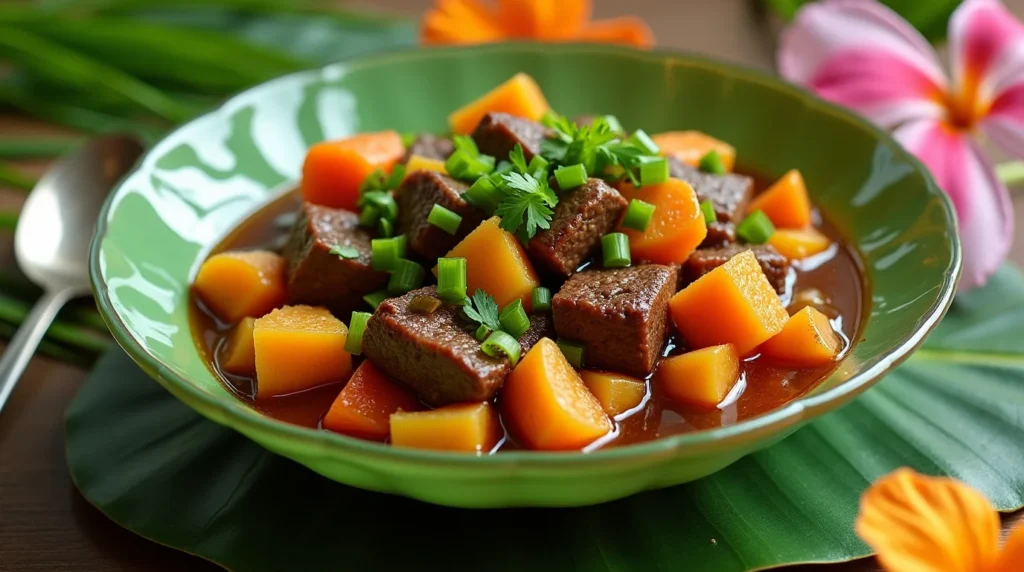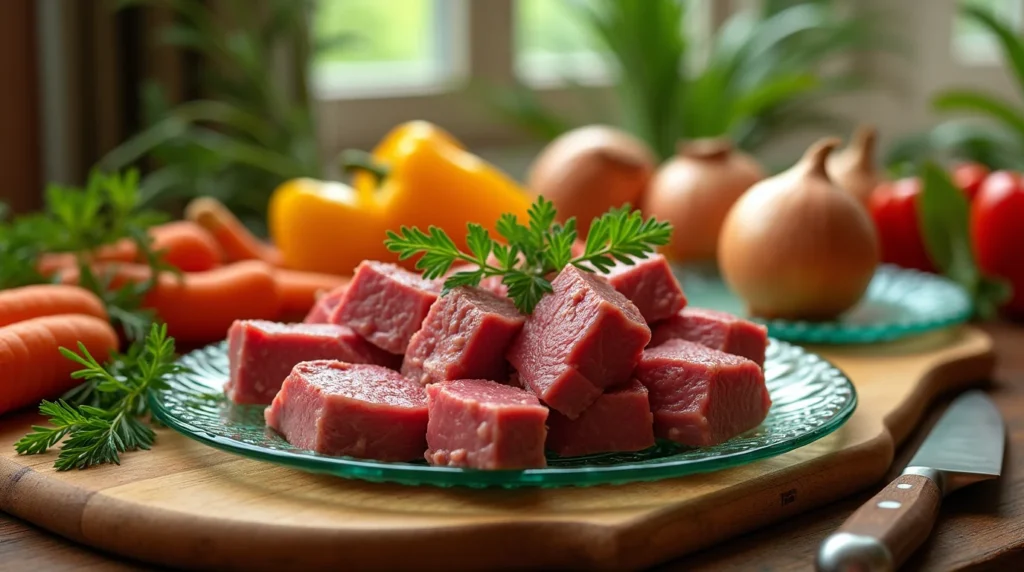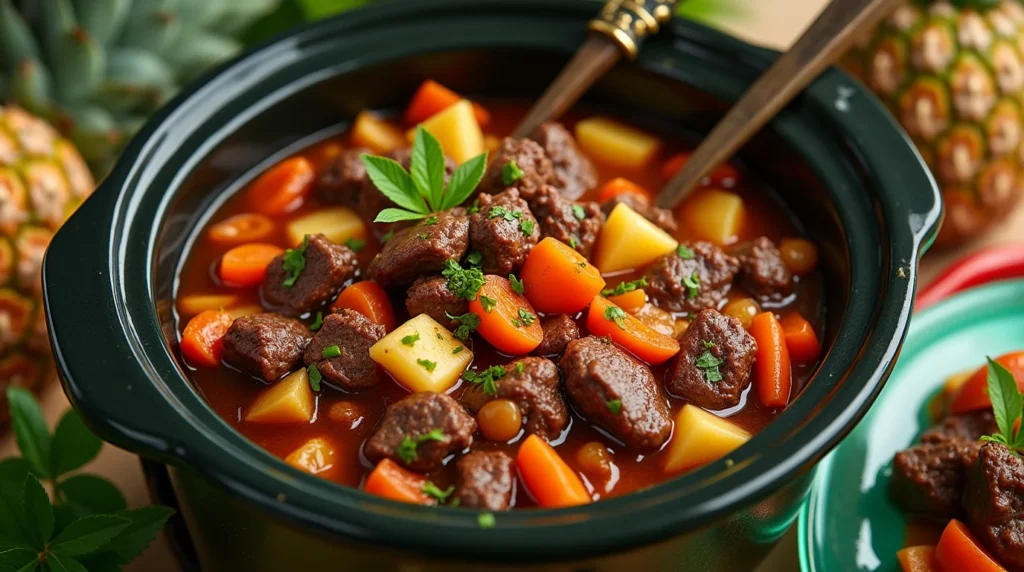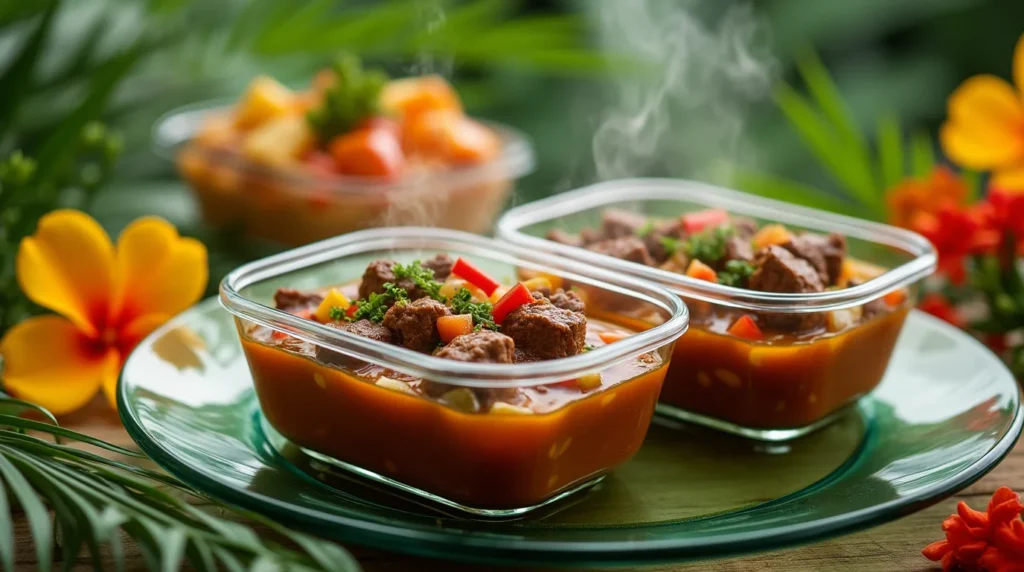
How to Make the Best Hawaiian Beef Stew Recipe at Home
Share this recipe
The smell of Hawaiian beef stew reminds me of my grandmother’s kitchen in Honolulu. It was more than food; it was a link to our family’s past. Every bite shared stories of tradition, comfort, and the diverse tastes of Hawaiian cuisine.
If you want to taste the islands or try authentic Hawaiian beef, this stew is perfect. It combines tender beef, local veggies, and special spices for a dish that’s both cozy and adventurous.
I’ll show you how to make the ultimate Hawaiian beef stew recipe. It’s a true taste of island cooking.
Recipe Details
Serving Size: 4-6 servings | Prep Time: 30 minutes | Cook Time: 2-3 hours | Total Time: 3-3.5 hours
Ingredients per Serving
- 2 lbs beef chuck, cubed
- 2 large potatoes, chopped
- 2 carrots, sliced
- 1 onion, diced
- 2 cups beef broth
- 1/4 cup soy sauce
Nutritional Facts (per serving)
- Calories: 380
- Protein: 35g
- Carbohydrates: 22g
- Fat: 18g
- Fiber: 3g
- Sodium: 620mg
- Sugar: 4g
Key Takeaways
- Hawaiian beef stew blends multicultural culinary influences
- Slow cooking is essential for tender, flavorful meat
- Local ingredients make the most authentic stew
- Versatile recipe adaptable to various cooking methods
- Perfect comfort food with rich island flavors
Understanding the Rich History of Hawaiian Beef Stew
Hawaiian cuisine is a story of cultural mix and new flavors. The beloved beef stew is more than food. It shows the island’s rich mix of cultures.
The dish’s roots go deep into Hawaii’s diverse culture. Island flavors come from a mix of:
- Portuguese sailors’ cooking techniques
- Chinese immigrant agricultural practices
- Native Hawaiian ingredient traditions
- Japanese culinary methods
Origins of Local Hawaiian Cuisine
Hawaiian cuisine grew from cultural exchange over time. Tropical ingredients like taro and sweet potatoes are key. The beef stew is a perfect mix of these flavors.
“Food is the universal language that connects people across cultures” – Hawaiian Culinary Historian
Cultural Significance in Island Communities
In Hawaiian communities, the stew is more than food. It stands for hospitality, family, and shared history. Each family’s recipe holds memories and traditions.
Evolution of Traditional Recipe
Over time, the Hawaiian beef stew changed. It went from a simple dish to a rich, flavorful meal. Today, chefs keep traditional methods alive while adding new twists.
Essential Ingredients for Authentic Hawaiian Beef Stew Recipe
To make a real Hawaiian beef stew, you need to pick the right tropical ingredients. These ingredients bring the true taste of island food to your dish.
The key to a traditional Hawaiian beef stew is its ingredients. Start with these must-haves:
- Tender beef chunks (preferably chuck roast)
- Rich coconut milk for creamy depth
- Hearty taro root for authentic Hawaiian flavor
- Local root vegetables
- Robust seasonings
“The secret to an exceptional Hawaiian beef stew is balancing tropical ingredients with traditional cooking techniques.”
Tropical ingredients are key to making your Hawaiian beef stew stand out. Taro, a Hawaiian favorite, adds a special earthy taste and creamy feel. The coconut milk makes the stew rich and island-like.
Choose fresh, local ingredients for the best taste. If taro is hard to find, try frozen taro or sweet potatoes. The goal is to keep the dish’s true flavor.
- Recommended substitutes for hard-to-find ingredients
- Local farmer’s market shopping tips
- Seasonal ingredient considerations
With careful ingredient selection, your Hawaiian beef stew will be a hit. It will bring the lively tastes of the islands right to your table.
Equipment and Kitchen Tools You'll Need
Preparing delicious Hawaiian beef stew needs the right kitchen tools. Whether you’re a traditional cook or a modern kitchen enthusiast, the right tools can make a big difference. They can enhance your slow cooker recipes and beef recipes.
Traditional Cooking Vessels
Hawaiian cuisine values traditional cooking methods. For authentic stew recipes, consider these classic tools:
- Cast-iron Dutch oven
- Clay pot (traditional Hawaiian imu style)
- Heavy-bottomed ceramic cookware
Modern Kitchen Alternatives
Modern cooking technology offers easy options for beef recipes. Explore these contemporary kitchen tools:
- Electric slow cookers
- Instant Pot
- Multi-function pressure cookers
Time-Saving Appliances
If you want to make cooking easier, get appliances that simplify stew recipes. A good slow cooker can change how you make Hawaiian beef stew. It lets you create rich, flavorful meals with less effort.
“The right tool can elevate a simple recipe into an unforgettable culinary masterpiece.” – Hawaiian Cooking Expert
When picking your cooking equipment, look for durability, heat distribution, and versatility. This ensures the best results for your Hawaiian beef stew.
Selecting and Preparing the Perfect Beef Cuts

Choosing the right beef cuts is key for a great hawaiian beef stew recipe. The meat you pick can make or break the dish. So, let’s explore the best cuts for tasty beef recipes.
Chuck roast is the top choice for traditional Hawaiian beef stew. It has the perfect mix of flavor and tenderness. Look for cuts with good marbling for a rich, melt-in-your-mouth texture when slow-cooked.
- Chuck roast (recommended)
- Short ribs
- Beef brisket
- Round steak
“The secret to an amazing Hawaiian beef stew is selecting meat that can withstand long, slow cooking while maintaining incredible flavor.”
Here are the essential steps for preparing your beef:
- Trim excess fat, leaving some for flavor
- Cut meat into 1-2 inch cubes
- Pat meat dry with paper towels
- Season generously with salt and pepper
Pro tip: Let your beef sit at room temperature for 30 minutes before cooking. This ensures even cooking and makes the meat tender in your hawaiian beef stew recipe.
Remember, quality meat turns a good stew into an exceptional culinary experience.
Traditional Hawaiian Vegetables and Their Preparation
Hawaiian cuisine celebrates the vibrant world of tropical ingredients. It turns simple vegetables into extraordinary culinary experiences. The rich agricultural heritage of the Hawaiian Islands provides an incredible array of produce. This elevates traditional beef stew to new heights of flavor.
Exploring the unique vegetables in Hawaiian cooking reveals a fascinating connection to the land and cultural traditions. The vegetables used in Hawaiian cuisine are not just ingredients. They represent a deep-rooted connection to the islands’ agricultural history.
Root Vegetables in Hawaiian Cuisine
Taro stands out as a cornerstone of Hawaiian vegetable preparation. This versatile root vegetable brings remarkable depth to many traditional dishes:
- Provides a creamy texture to stews
- Offers high nutritional value
- Connects to indigenous Hawaiian agricultural practices
Local Produce Selection Guide
When selecting vegetables for your Hawaiian beef stew, prioritize fresh, local ingredients. Look for produce that showcases the islands’ unique growing conditions:
- Choose firm, unblemished root vegetables
- Select seasonal local produce
- Support local Hawaiian farmers
Proper Cutting Techniques
Mastering vegetable preparation can dramatically improve your stew’s texture and flavor. Uniform cutting ensures even cooking and consistent taste. Cut root vegetables like taro into similar-sized chunks to guarantee perfect tenderness.
“In Hawaiian cooking, how you prepare vegetables is just as important as the ingredients themselves.” – Traditional Hawaiian Chef
Step-by-Step Hawaiian Beef Stew Recipe
Making a true Hawaiian beef stew recipe needs patience and care. It turns simple ingredients into a delicious dish that feels like a trip to Hawaii.
Begin by picking the right beef for stew. Choose chuck roast or bottom round. These cuts get tender when cooked slowly.
- Cut beef into 1-inch cubes, patting them dry with paper towels
- Season meat generously with salt and black pepper
- Brown meat in a large Dutch oven with vegetable oil
- Remove browned meat and set aside
For the base, mix beef broth and tomato sauce. The secret to a great Hawaiian beef stew is rich, deep flavors.
“Cooking is fueled by passion, often appearing somewhat unpredictable and assertive to an observer.” – Gordon Ramsay
- Add onions and garlic to the same pot
- Deglaze with red wine or beef stock
- Return meat to the pot
- Add root vegetables like potatoes and carrots
Let your Hawaiian beef stew simmer on low heat for 2-3 hours. This makes the meat tender. You’ll get a comforting, flavorful dish that’s true to Hawaiian home cooking.
Secret Tips for Authentic Island Flavors
Unlocking the true essence of Hawaiian cuisine is more than just following a recipe. It’s about the delicate dance of tropical ingredients and traditional cooking techniques. These elements turn an ordinary beef stew into a memorable culinary experience.
Mastering Hawaiian cuisine means understanding the subtle art of seasoning and preparation. The magic lies in the details that bring your dish to life.
Traditional Seasoning Combinations
Your island-inspired beef stew comes alive with these key seasoning techniques:
- Use Hawaiian sea salt for authentic mineral-rich flavor
- Incorporate ginger and garlic as foundational spices
- Experiment with soy sauce for depth and umami
Local Cooking Methods
Traditional Hawaiian cooking embraces slow, gentle preparation. Low and slow cooking allows tropical ingredients to meld together. This creates rich, complex flavors that tell a story of island cuisine.
“Cooking is about passion, and in Hawaii, that passion is infused into every dish.” – Local Hawaiian Chef
Flavor Enhancement Techniques
To elevate your Hawaiian beef stew, consider these professional tips:
- Marinate meat overnight in local seasonings
- Use fresh, locally sourced vegetables
- Allow stew to rest before serving to intensify flavors
By embracing these techniques, you’ll transform a simple recipe into an authentic Hawaiian culinary journey.
Slow Cooker and Instant Pot Variations

Modern kitchen tech has changed how we make Hawaiian beef stew. Now, you can enjoy this island dish with less effort. Slow cookers and Instant Pots make it easy.
When using these modern appliances, a few tweaks are key for great taste:
- Adjust liquid ratios to prevent over-saturating the meat
- Reduce cooking times to maintain meat tenderness
- Layer ingredients strategically for maximum flavor absorption
Slow cookers need 6-8 hours on low or 3-4 hours on high. The Instant Pot cuts cooking time to 35-45 minutes. This is perfect for those with busy schedules.
“The secret is maintaining the authentic flavors while embracing modern cooking techniques.”
Here are some tips for the best results with each appliance:
- Brown meat before slow cooking to enhance flavor development
- Use fresh local ingredients for authentic taste
- Allow natural pressure release in Instant Pot for optimal meat texture
Both methods bring unique benefits. You can enjoy a traditional Hawaiian beef stew with modern convenience.
Serving Suggestions and Side Dishes
Enhancing your Hawaiian beef stew experience is more than just the main dish. The right sides can turn your meal into a true Hawaiian feast. Learning how to pair dishes will make your dining experience unforgettable, capturing the essence of island flavors.
Traditional Hawaiian Side Dishes
Consider these classic Hawaiian sides with your beef stew:
- Steamed white rice – a staple in Hawaiian meals
- Laulau – traditional wrapped leaf-based dish
- Fresh poi – fermented taro root paste
- Macaroni salad – a local favorite
Modern Pairing Options
For a modern twist, try these side dish combinations:
- Roasted sweet potato wedges
- Grilled pineapple salsa
- Coconut quinoa
- Crisp green papaya slaw
“The magic of Hawaiian cuisine lies in its ability to blend traditional ingredients with modern culinary creativity.” – Hawaiian Food Expert
Your beef stew needs sides that match its rich flavors. Whether you go for traditional laulau or modern sides, aim for balance and taste that shows true island flavors.
Storage Tips and Leftover Ideas

Keeping your Hawaiian beef stew fresh is important. Cool the dish completely before storing. This helps keep its flavors intact.
For storing stew, choose the right containers. Airtight containers or heavy-duty freezer bags work best. Here’s how to store your stew:
- Refrigerate within 2 hours of cooking
- Store in shallow containers for quick cooling
- Keep refrigerated for up to 3-4 days
- Freeze for extended storage up to 3 months
Reheating leftover stew needs care. Slow and steady wins the flavor race! Here’s how to reheat:
- Stovetop: Warm over low heat, stirring occasionally
- Microwave: Use medium power and stir every 30 seconds
- Oven: Cover and reheat at 350°F until heated through
“Leftover stew is a treasure that continues to delight with every serving.” – Hawaiian Home Cook
Get creative with leftover stew. Serve it over rice, stuff it into tacos, or use it as pie filling. Each new dish brings a fresh twist to your stew.
Troubleshooting Common Recipe Issues
Making the perfect hawaiian beef stew recipe can be tough, even for experts. Knowing common problems helps you make a tasty dish with real island flavors.
When you’re cooking beef recipes like this stew, you might face some issues. Let’s look at ways to improve your cooking skills.
Texture Problems and Solutions
- Tough meat: Choose chuck roast and cook slowly at low temperatures
- Dry beef: Ensure sufficient liquid and cover while cooking
- Watery sauce: Reduce heat and let stew simmer uncovered
Flavor Balance Adjustments
Seasoning stew recipes needs care. Start with a little salt and spices, tasting as you go. The goal is to make small, gradual changes.
“Cooking is about balance, not perfection” – Local Hawaiian Chef
Common Mistakes to Avoid
- Cutting meat too large
- Overcrowding the pot
- Rushing the cooking process
- Skipping meat browning
By knowing these tips, you’ll make a hawaiian beef stew that’s as good as restaurant food.
Conclusion
Your journey through the Hawaiian beef stew recipe has shown you the beauty of island cuisine. This dish is more than food; it’s a celebration of Hawaiian traditions. It connects family, history, and vibrant flavors.
By mastering this recipe, you’ve learned to turn simple ingredients into a memorable meal. This meal captures the essence of Hawaiian cuisine.
The Hawaiian beef stew recipe showcases the creativity of island cooking. Each ingredient has a story, from tender beef to locally grown vegetables. Now, you can make these authentic flavors in your kitchen.
Remember, cooking is about passion, creativity, and tradition. Whether for a family gathering or a quiet dinner, you’re part of a long tradition of Hawaiian home cooks.
Let the spirit of aloha guide your cooking. Each bite of this stew brings you closer to the warm, welcoming islands. Your journey into Hawaiian cuisine is just starting. Keep exploring, cooking, and enjoying the delicious flavors.









